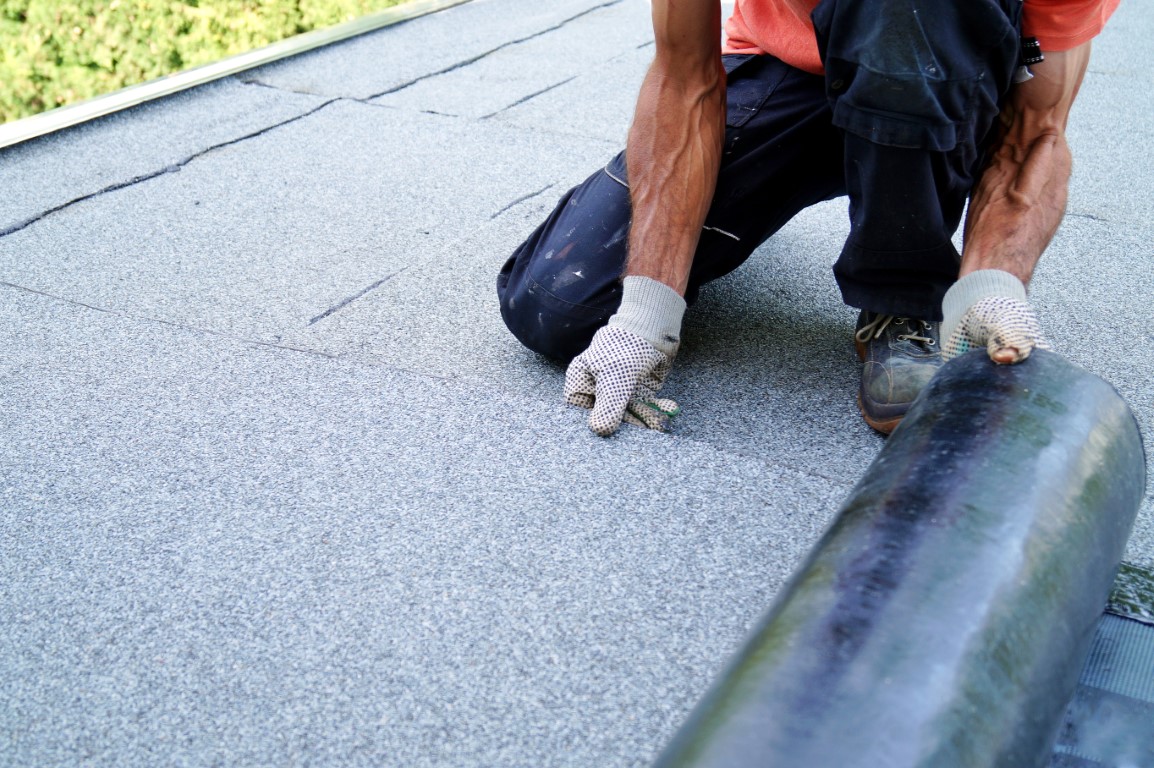Flat roofs are a fantastic option for the Canadian climate, but they come with their own set of challenges that homeowners and property managers must address. One of the most critical issues that can arise is water pooling on the roof surface, commonly known as “ponding.” While it may seem like a minor concern at first, water pooling on a flat roof can lead to serious consequences if left unaddressed.
Understanding Ponding on Flat Roofs
Ponding water occurs when rainwater, melted snow, or precipitation collects in puddles on the surface of a flat roof. Unlike pitched roofs that allow water to naturally drain away, flat roofs lack the inherent slope required for efficient water runoff. As a result, water may linger on the roof for extended periods, forming ponds.
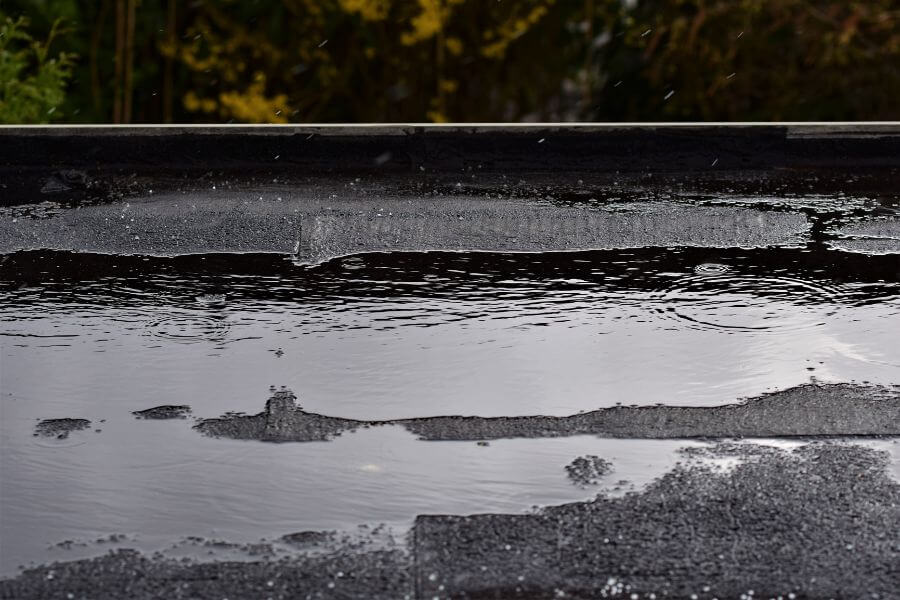
Why is Ponding a Problem?
While the presence of a little water may not seem like an immediate threat, ponding water can lead to a cascade of negative effects that compromise the integrity of the roof and the entire building. Here’s why it’s essential to address water pooling promptly:
Increased Leak Risk
Ponding water can infiltrate even the most robust roofing materials over time. This water penetration can lead to leaks that can damage the interior of the building, its structural components, and valuable possessions.
Accelerated Roof Aging
The prolonged presence of ponding water expedites the aging process of roofing materials. This occurs due to the combined effects of water exposure, intensified UV degradation caused by sunlight passing through the water, and the accumulation of debris. As a result, the expected lifespan of the roof can be significantly shortened, leading to potential replacements sooner than anticipated.
Roof Sagging
The weight of standing water places immense stress on the roof’s structure, which can lead to a phenomenon known as roof sagging. This compromise in structural integrity not only affects the appearance of the roof but also impairs its load-bearing capacity, potentially posing safety risks to the building’s occupants.
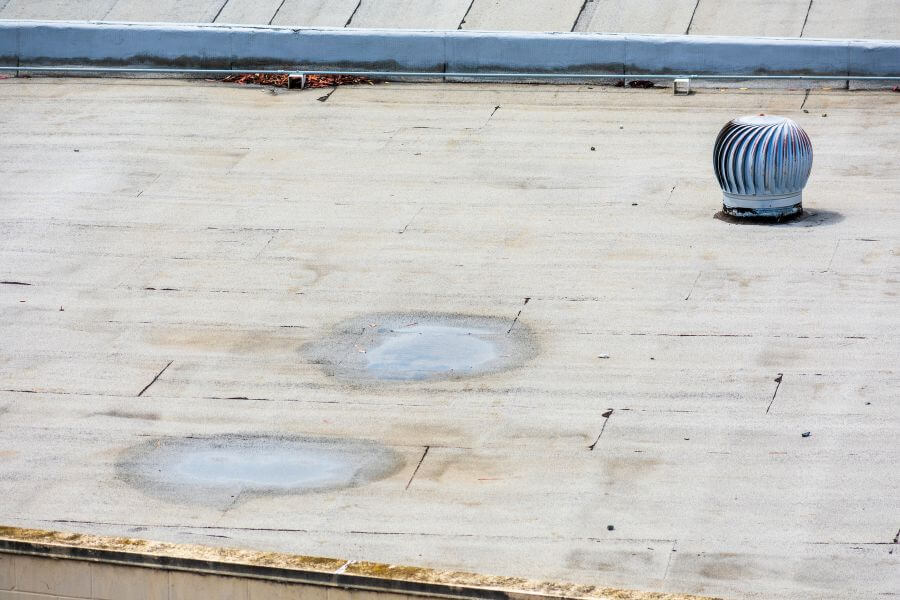
Deterioration of Roofing Materials
Consistent exposure to pooled water weakens roofing materials, causing them to deteriorate prematurely. This deterioration manifests in the form of cracks, brittleness, and other signs of structural compromise. The compromised materials are not only visually unappealing but also less effective in providing the necessary protection for the building.
Moss, Algae, and Plant Growth
Moist conditions created by ponding water create an environment conducive to the growth of moss, algae, and other types of vegetation. These organisms not only mar the aesthetic appeal of the roof but can also exacerbate the deterioration of roofing materials. Additionally, their presence can impact the roof’s ability to effectively shed water.
Damage to the Roof Membrane
Ponding water wears down the roof membrane over time. This erosion diminishes the membrane’s efficacy as a vital protective barrier against external elements, leaving the roof vulnerable to various forms of damage.
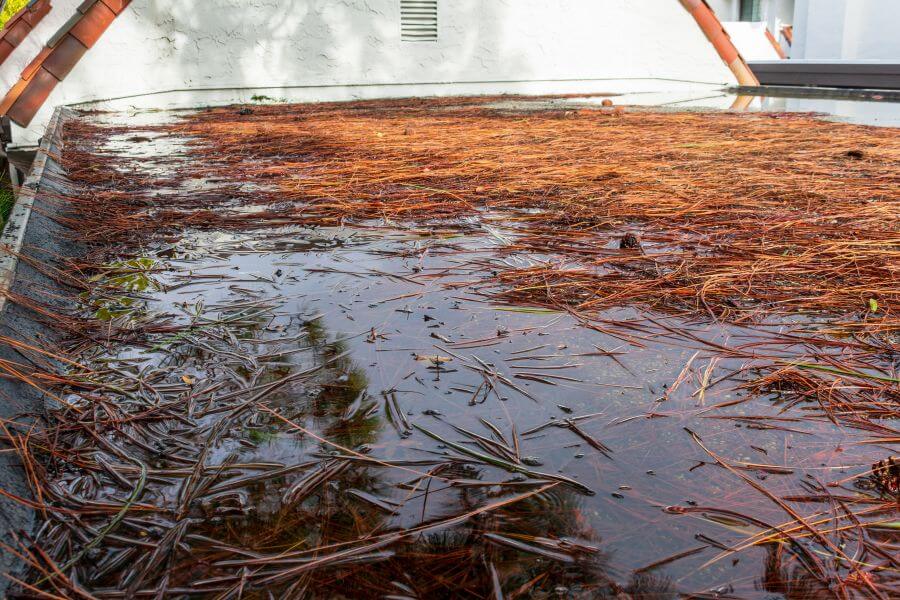
Causes of Ponding Water
Understanding the causes of ponding is crucial for implementing effective solutions. Several factors can contribute to water pooling on a flat roof:
Blocked Drains or Gutters
One of the most common causes of ponding water on flat roofs is the obstruction of drains and gutters by debris and leaves. Over time, leaves, twigs, and other rooftop debris can accumulate in these drainage systems, impeding the smooth flow of water. As these openings become blocked, rainwater and precipitation are unable to drain away efficiently, leading to the formation of stagnant pools on the roof’s surface. Addressing this issue requires regular maintenance and clearing of drains and gutters to ensure unobstructed water flow and prevent ponding.
Incorrect Roof Pitching
Proper roof pitch, or slope, is essential for ensuring effective water runoff on flat roofs. However, if a flat roof is poorly pitched or lacks the necessary slope, water will struggle to flow towards the designated drains. This deficiency in drainage can lead to water pooling in depressions and low spots on the roof’s surface. Without the guiding force of gravity, the water will remain stagnant and increase the risk of damage to the roof structure and materials. Rectifying incorrect roof pitching requires professional assessment and adjustment to establish the proper slope that promotes efficient water drainage.
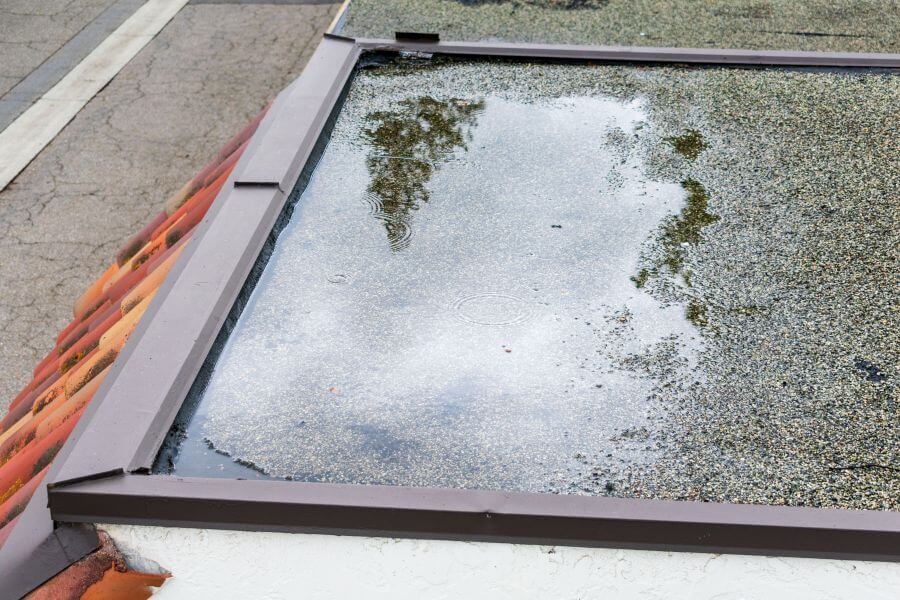
Excessive Roofing Material
Another factor contributing to water ponding on flat roofs is the accumulation of excessive roofing material along the edges. When roof materials such as gravel, tar, or shingles build up along the roof’s perimeter, they create barriers that hinder the natural flow of water toward the drains. As a result, water collects in the areas behind these accumulations, forming ponds that can lead to a range of issues. Ensuring a clear path for water runoff by removing excess roofing material from the edges is crucial to preventing ponding.
Improper Flashing Installation
Flashing, an essential component for waterproofing flat roofs, can inadvertently contribute to ponding if improperly installed. Flashing, which is intended to channel water away from vulnerable areas, can fail in its function if not correctly positioned. Incorrect installation may lead to water being trapped behind the flashing, preventing its smooth flow off the roof’s surface. This trapped water can exacerbate ponding issues, ultimately causing damage to the roof structure and materials. Proper installation of flashing by qualified professionals is vital to ensuring effective water drainage and preventing ponding.
Structural Irregularities
Design flaws in the building’s structure, such as deformities in joists or beams, can create low spots or depressions on the flat roof’s surface. These irregularities disrupt the natural flow of water, causing it to accumulate in these lower areas and form pools. Structural weaknesses may lead to further complications, as the weight of standing water can stress the roof’s load-bearing capacity. Rectifying these irregularities often requires the expertise of experienced contractors who can assess the situation and implement solutions that restore proper drainage and prevent ponding.
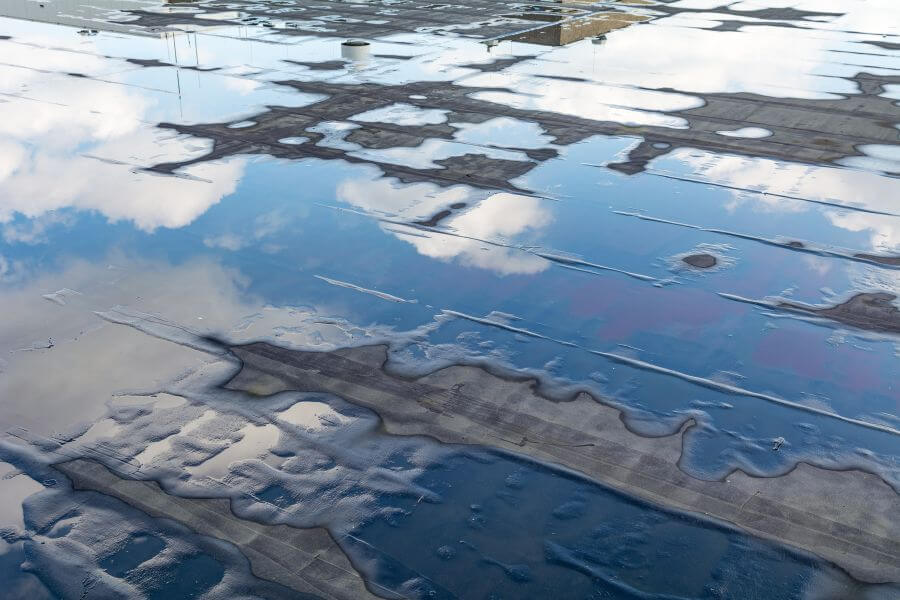
Solving the Ponding Issue
To mitigate the risks associated with ponding water, it’s crucial to implement appropriate solutions. Depending on the underlying cause, here are some strategies to consider:
Clear Drains and Gutters
Routinely clearing drains and gutters of accumulated debris, such as leaves and twigs, is essential to maintain unobstructed water flow. Regular maintenance ensures that rainwater and precipitation can swiftly drain away, minimizing the risk of ponding.
Fix Roof Pitching
In cases where the roof lacks the appropriate pitch for efficient water runoff, seek the expertise of one of our professionals to rectify the slope. Correcting the roof’s pitch will enable water to flow naturally toward drains and reduce the likelihood of ponding. Contact us today for a free quote!
Install Crickets
To divert water away from potential pooling areas, consider installing crickets. These tapered insulation structures are particularly effective around rooftop units and skylights, ensuring that water is directed toward drainage points.
Replace Crushed Insulation
Take action to rectify compressed or damaged insulation, as it can create depressions on the roof’s surface that trap water. By addressing insulation issues, you can eliminate potential areas of ponding
Resolve Structural Irregularities
If structural flaws are contributing to ponding, consult one of our Industrial Roofing professionals to assess and address the irregularities. Ensuring proper water flow through structural adjustments is crucial to preventing ponding.
Consider Additional Drains
In regions known for high precipitation, consider adding supplementary drains to enhance water drainage capabilities. Adequate drainage systems can effectively prevent ponding, especially during heavy rainfall.
Regular Maintenance
Implement a schedule of routine flat roof maintenance to proactively identify and address potential issues before they escalate. Early detection allows for timely intervention and prevents the exacerbation of ponding-related problems.
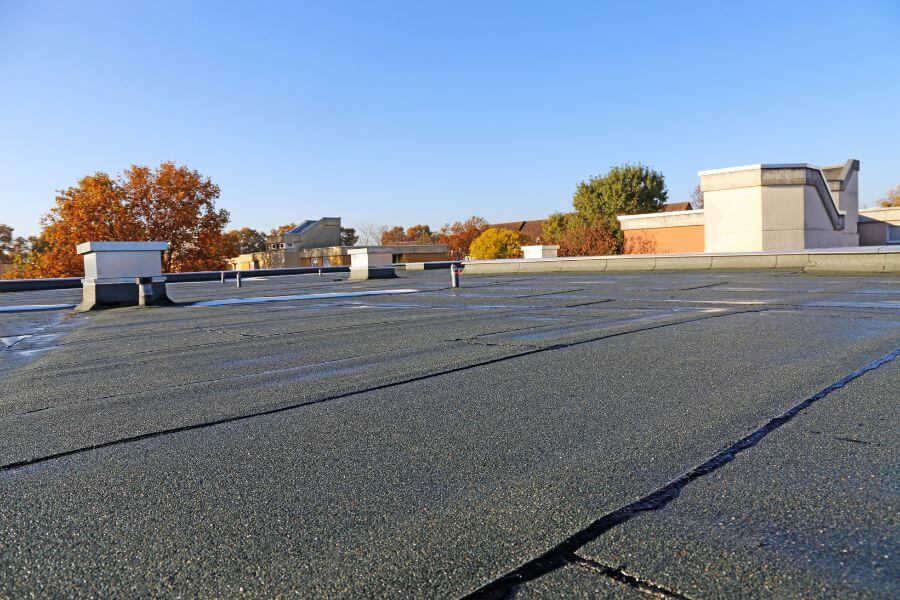
Water pooling on a flat roof should not be underestimated. While ponding water might not immediately threaten the roof’s integrity, its long-term effects can lead to leaks, roof sagging, material deterioration, and even accelerated aging. By understanding the causes and potential risks of ponding, you can take proactive steps to address the issue promptly. Consulting our experienced roofing professionals and implementing appropriate solutions will help ensure the longevity and performance of your flat roof while safeguarding your investment.


